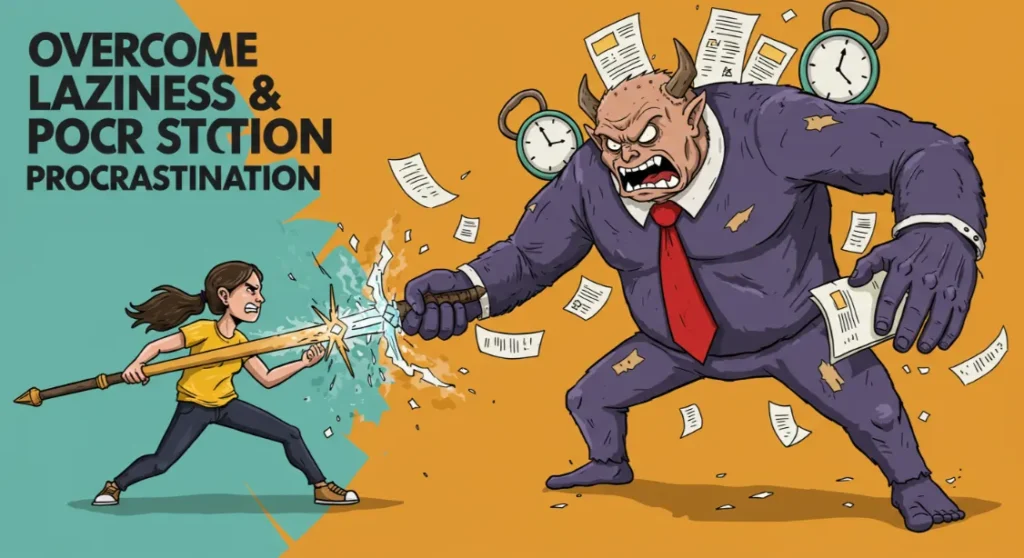Habit stacking is a powerful technique that helps you build new habits by attaching them to existing ones. Instead of relying on willpower or motivation, habit stacking leverages your current routines to make new behaviors almost automatic. This simple yet effective approach can transform your productivity, wellness, and personal growth with minimal effort.
Habit stacking works because it uses the neural pathways of established habits as a foundation for new ones. When you consistently pair a new action with something you already do automatically, your brain begins to link them together, making the new habit much easier to maintain.
Key Takeaways
- Habit stacking attaches new habits to existing routines, making them easier to remember and maintain
- The formula is simple: “After I [current habit], I will [new habit]”
- Small, consistent actions lead to significant long-term results
- Habit stacking works by using existing neural pathways in your brain
- Research shows properly stacked habits have up to 80% higher success rates
- Start with tiny habits (under 2 minutes) for the best results
What Is Habit Stacking?
Habit stacking is a behavior-change strategy first popularized by S.J. Scott in his 2014 book “Habit Stacking: 97 Small Life Changes That Take Five Minutes or Less” and further developed by James Clear in “Atomic Habits.” The concept is beautifully simple: identify a current habit you already do daily, then stack a new habit immediately after it.
The basic formula looks like this:
“After I [current habit], I will [new habit].”
For example:
After I brush my teeth, I will do 10 push-ups
After I pour my morning coffee, I will meditate for two minutes
After I sit down at my desk, I will write down my top three priorities for the day
This approach works because you’re not trying to create a completely new routine from scratch. Instead, you’re taking control of your day by using existing behavior as a trigger for the new one.
The Science Behind Habit Stacking

Habit stacking works because it leverages how our brains form neural pathways. When you repeatedly perform an action after a specific cue, your brain creates stronger connections between them. Eventually, the cue automatically triggers the behavior without conscious thought.
This process is rooted in the concept of “implementation intentions” from psychology research. Studies show that people who explicitly plan when and where they’ll perform a new habit are far more likely to follow through. Habit stacking provides this clear implementation plan by connecting new behaviors to existing routines.
The science of stress also explains why habit stacking is effective. Creating new habits from scratch requires significant mental energy and willpower, which depletes quickly when we’re stressed. By attaching new behaviors to existing ones, we reduce the cognitive load and make consistency possible even during challenging times.
How to Start Habit Stacking
Getting started with habit stacking is straightforward if you follow these steps:
1. Identify Your Current Habits
Begin by listing the automatic behaviors you already perform daily. These become the foundation for your habit stacks. Common anchors include:
Morning routines (brushing teeth, making coffee, showering)
Work transitions (sitting down at your desk, checking email)
Evening routines (changing clothes, washing dishes)
Location-based habits (arriving home, entering the kitchen)
The best anchor habits are ones you do consistently without fail. They become reliable triggers for your new behaviors.
2. Choose Small New Habits
Select new habits that take less than two minutes to complete initially. Small habits have a much higher success rate because they require minimal motivation and effort. You can always expand them later once they become automatic.
For example, if you want to develop a meditation for productivity practice, start with just one minute of meditation after your morning coffee rather than committing to 20 minutes.
3. Create Clear Habit Stacks
Formulate specific habit stacking statements using the formula: “After I [current habit], I will [new habit].” Write these down and post them where you’ll see them during your routine.
Be precise about exactly when and how you’ll perform the new habit. For example: “After I turn off my morning alarm, I will immediately do five minutes of stretching before getting out of bed.”
4. Start With One Stack at a Time

Resist the temptation to transform your entire routine overnight. Begin with just one or two habit stacks and master them before adding more. This approach prevents overwhelm and increases your chances of success.
Once your first habit stack becomes automatic (usually after 2-8 weeks of consistent practice), you can introduce additional stacks or expand existing ones.
Powerful Habit Stacking Examples
Here are some effective habit stacks organized by different areas of life:
For Productivity
After I sit down at my desk, I will write down my three most important tasks for the day
After I finish a Zoom call, I will immediately block 10 minutes to process any action items
After I check my email, I will focus on one task for 25 minutes without interruption
For Health and Wellness

After I brush my teeth in the morning, I will do 10 push-ups
After I take off my work shoes, I will change into workout clothes
After I pour my morning coffee, I will drink a full glass of water
For Personal Development
After I get into bed, I will read one page of a book
After I park my car at home, I will listen to 5 minutes of an educational podcast before going inside
After I finish dinner, I will practice a language learning app for 3 minutes
For Mental Wellbeing

After I wake up, I will list three things I’m grateful for
After I start the shower, I will do 60 seconds of deep breathing while the water warms up
After I turn off my computer at the end of the workday, I will write down one accomplishment from the day
The key is to connect your new habits to specific triggers that happen consistently in your environment or routine. This creates a natural flow from one behavior to the next.
Common Habit Stacking Mistakes to Avoid

Even with a strategy as effective as habit stacking, there are pitfalls that can derail your progress:
1. Starting Too Big
One of the most common mistakes is trying to add habits that are too ambitious. Remember that the goal is consistency, not perfection. Start with tiny habits that take less than two minutes to complete.
For example, instead of “After dinner, I’ll exercise for an hour,” try “After dinner, I’ll put on my running shoes and step outside for one minute.” This mini habit approach makes it nearly impossible to fail.
2. Choosing Unreliable Trigger Habits
Your anchor habits must be consistent for habit stacking to work. If you choose triggers that don’t happen reliably (like “when I feel inspired”), your new habit won’t stick.
Choose triggers that happen at the same time, in the same context, every single day—regardless of your motivation or circumstances.
3. Stacking Too Many Habits at Once
Adding too many new habits simultaneously is a recipe for overwhelm. Your willpower is limited, so focus on mastering one or two habit stacks before adding more.
Once your first habit stack becomes automatic, it actually creates more mental bandwidth for additional habits.
4. Ignoring the Environment

Your physical environment plays a crucial role in habit formation. If your new habit requires specific tools or resources, make sure they’re readily available at the moment of your trigger.
For example, if your habit stack is “After I make my bed, I will meditate for two minutes,” ensure your meditation cushion or app is right there waiting for you.
Advanced Habit Stacking Strategies
Once you’ve mastered basic habit stacking, try these advanced techniques:
Habit Chaining
Create longer sequences by linking multiple habits together. Each new habit becomes the trigger for the next one, creating a chain of positive behaviors.
For example:
After I turn off my alarm, I will make my bed
After I make my bed, I will do five push-ups
After I do push-ups, I will drink a glass of water
After I drink water, I will meditate for one minute
This approach helps you build a morning routine for success that flows naturally from one activity to the next.
Habit Stacking for Breaking Bad Habits
You can also use habit stacking to overcome negative behaviors by inserting a new habit between the cue and the unwanted routine.
For example, if you habitually check social media when you feel bored, your stack might be: “When I feel the urge to check social media, I will first do 10 seconds of deep breathing and then decide if I still want to check it.”
This pattern interruption gives you space to make a conscious choice rather than acting on autopilot.
Visualization with Habit Stacking
Combine habit stacking with visualization for goals to enhance your results. After completing your habit stack, take 30 seconds to visualize yourself successfully performing the habit again tomorrow.
This mental rehearsal strengthens the neural pathways associated with your new behavior and increases the likelihood you’ll repeat it.
Tracking and Maintaining Your Habit Stacks
Consistency is the key to successful habit stacking. These strategies will help you stay on track:
Use a Habit Tracker
Track your progress with a simple habit tracker. This could be a paper journal, a spreadsheet, or a dedicated app. The act of checking off completed habits provides a small dopamine boost that reinforces your behavior.
A self-improvement journal can be particularly effective for monitoring multiple habit stacks while reflecting on your progress.
Create Accountability
Share your habit stacking goals with someone else or join a community focused on habit building. External accountability dramatically increases follow-through when motivation wanes.
Consider finding an accountability partner who is also working on building new habits. Regular check-ins can keep you both on track.
Plan for Obstacles
Identify potential obstacles in advance and create specific plans for overcoming them. This “if-then” planning helps you maintain consistency even when life gets chaotic.
For example: “If I can’t do my usual morning habit stack because I’m traveling, then I’ll do a simplified version that includes just the three most important elements.”
Reward Yourself
Build rewards into your habit stacking system. After completing your habit stack consistently for a week, reward yourself with something meaningful that reinforces your new identity.
The reward doesn’t need to be large—even small celebrations help reinforce the neural pathways associated with your new habits.
Transforming Your Life Through Habit Stacking
The true power of habit stacking lies in its compound effect over time. Small, consistent actions accumulate into significant life changes when performed regularly.
By mastering the art of habit stacking, you can:
Build a solid foundation of positive daily behaviors
Reduce the friction of starting new habits
Create more time for what matters by automating routine decisions
Develop a greater sense of control and accomplishment
Gradually transform your identity through consistent actions
Remember that habit formation is not about perfection but consistency. Even if you miss a day, simply return to your habit stack the next day without judgment. The goal is progress, not perfection.
As James Clear writes, “You do not rise to the level of your goals. You fall to the level of your systems.” Habit stacking helps you build robust systems that make positive behaviors inevitable rather than exhausting.
Conclusion
Habit stacking is a remarkably effective strategy for building new habits with minimal resistance. By leveraging your existing routines as triggers for new behaviors, you create a natural flow that makes consistency almost effortless.
Start small, be specific about your triggers, and focus on consistency rather than perfection. Over time, these tiny habits will compound into significant life improvements across all areas of your life.
Remember that lasting behavior change isn’t about massive action but about tiny, consistent steps in the right direction. Habit stacking gives you a practical framework to take those steps every single day.
Ready to transform your habits? Choose one existing routine and one small new habit to stack onto it. Start tomorrow morning and watch how this simple technique can revolutionize your approach to personal growth and productivity.
References:
- https://ppl-ai-file-upload.s3.amazonaws.com/web/direct-files/1044541/349fc5ea-87f9-4d16-bf9b-4fc2e0bb497e/paste.txt
- https://ppl-ai-file-upload.s3.amazonaws.com/web/direct-files/1044541/1c0450be-a17d-48c6-b759-dd6cf071785c/paste.txt
- https://gearuptogrow.com/mental-wellness/manage-work-stress/
- https://gearuptogrow.com/learning-dev
- https://gearuptogrow.com/category/personal-development/page/3/
- https://www.betterup.com/blog/habit-stacking
- https://gearuptogrow.com/personal-development/visualization-for-goals/
- https://www.harpersbazaar.com/uk/beauty/mind-body/a42635039/habit-stacking/
- https://gearuptogrow.com/blog/page/9/
- https://www.rd.com/article/habit-stacking/
- https://www.onepeloton.com/blog/habit-stacking/
- https://www.goodhousekeeping.com/life/a43660778/habit-stacking/
- https://www.aicr.org/resources/blog/what-is-habit-stacking-and-why-is-it-important/
- https://jamesclear.com/habit-stacking
- https://blog.hubspot.com/sales/habit-stacking
- https://health.clevelandclinic.org/habit-stacking
- https://fs.blog/habit-stacking/
- https://www.developgoodhabits.com/stacking-resources/